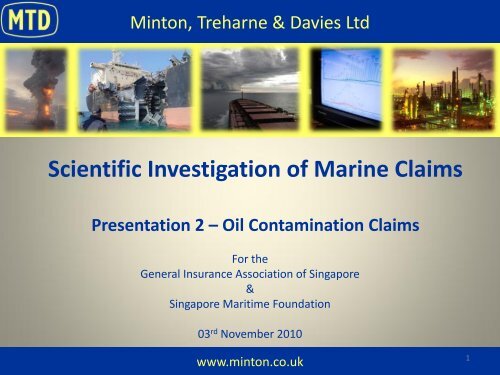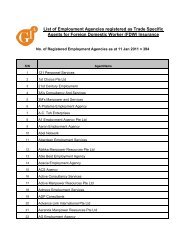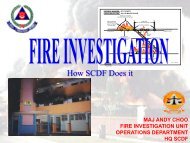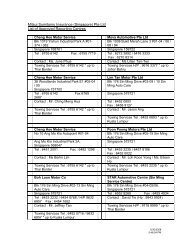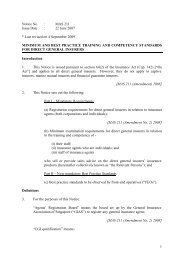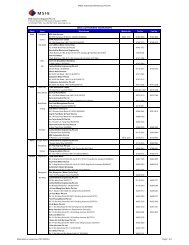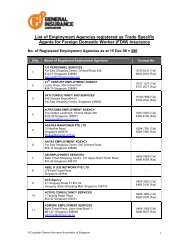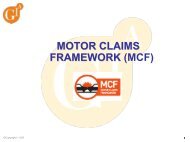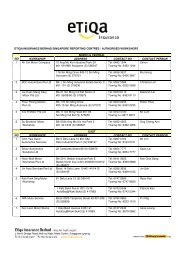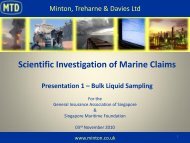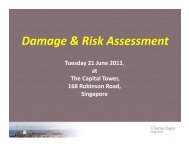Oil Contamination Claims - General Insurance Association Of ...
Oil Contamination Claims - General Insurance Association Of ...
Oil Contamination Claims - General Insurance Association Of ...
- No tags were found...
Create successful ePaper yourself
Turn your PDF publications into a flip-book with our unique Google optimized e-Paper software.
Minton, Treharne & Davies LtdScientific Investigation of Marine <strong>Claims</strong>Presentation 2 – <strong>Oil</strong> <strong>Contamination</strong> <strong>Claims</strong>For the<strong>General</strong> <strong>Insurance</strong> <strong>Association</strong> of Singapore&Singapore Maritime Foundation03 rd November 2010www.minton.co.uk1
Presentation Two<strong>Oil</strong> <strong>Contamination</strong> <strong>Claims</strong>www.minton.co.uk2
Presentation TwoTopics1. <strong>Oil</strong> cargoes2. Quality Specifications3. Routine Testing4. Quality Disputes5. <strong>Contamination</strong>s6. Investigative Methodologies7. Case Studieswww.minton.co.uk3
Presentation Two<strong>Oil</strong> Products• Many different liquid oil products areproduced, traded and shipped in bulkaround the world every day• Typical bulk liquid cargoes include:– Crude oil– Naphtha– Gasoline/Petrol– Kerosene/Jet Fuel– Diesel/Gasoil– Fuel <strong>Oil</strong>– Petrochemicals– Vegetable <strong>Oil</strong>s– Biofuelswww.minton.co.uk4
Presentation TwoQuality Specifications• The quality of a material is typically governed by the quality requirementsstipulated in the sales contract• These quality requirements are often internationally or nationallyrecognised standard quality specifications• A general quality specification should detail:– A list of the quality parameters to be determined– The units required for each test parameter– The limits (minimum and/or maximum) for each quality parameter– The specific test method used to determine each quality parameterwww.minton.co.uk5
Presentation TwoExample Quality Specification –EN 590 European Diesel Specificationwww.minton.co.uk6
Presentation TwoExample Quality Specification –ISO 8217 Marine Fuels Standardwww.minton.co.uk7
Presentation TwoRoutine Testing• The quality of the material is checked at various stages in the productmovement, for example:– Before Loading – Shore Tank samples– During Loading – Line/manifold/”first foot” samples– After Loading – Ship’s tank samples– Before discharge – Ship’s tank/receiving shore tank samples– During discharge – Manifold/line samples– After discharge – Shore tank samples• Inspection companies draw samples of the material at each stage in thecargo movement and test them against either the full specificationrequirements or certain key point tests• A quality problem should be picked up by this routine testingwww.minton.co.uk8
Presentation TwoQuality Dispute• If routine testing or sampling givesrise to a quality dispute this is wherewe get involved• A quality dispute arises when areceiver of goods claims them to be ofunsatisfactory quality, in contradictionto the Shipper’s / Load Port inspectorsreports showing them to be in goodorderwww.minton.co.uk9
Presentation TwoQuality Disputes• Quality disputes arise for 1 or more of 7 reasons1. The cargo was always off-specification, despite reports to the contrary2. The cargo received is in fact on-specification, despite reports to the contrary3. Different and incompatible test methods are being used at the load and discharge port4. Measurement tolerances5. The cargo suffers from inherent instability6. The cargo is physically damaged on voyage7. The cargo has been contaminated• Scenarios 1 to 5 can be thought of as “apparent” contaminations• Scenarios 6 relates to physical damage of the cargo, but not a contamination• Scenario 7 can be thought of as a “real” contamination• In normal circumstances only the last two would give rise to proper claim againstunderwriterswww.minton.co.uk10
Presentation TwoPrevious Cargoeswww.minton.co.uk11
Presentation Two<strong>Contamination</strong>s – Dirty/Damaged Tankswww.minton.co.uk12
Presentation Two<strong>Contamination</strong>s – Poor Quality Inert Gaswww.minton.co.uk13
Presentation Two<strong>Contamination</strong>s – Dirty Tanks from Poor IGwww.minton.co.uk14
Presentation TwoColour <strong>Contamination</strong>Before LoadingAfter Loadingwww.minton.co.uk15
• Questions to be answered:Presentation TwoMethod of Investigation– Is the contamination real?– What is the extent of thecontamination?– What is the contaminant?– When did the contaminationoccur?– Who caused the contamination?www.minton.co.uk16
Presentation TwoCase Studies• We are going to look at three different scenarios where there has been aquality dispute1. An “apparent “contamination2. A “real” contamination3. An oddball investigationwww.minton.co.uk17
Presentation TwoCase Study 1 – An Apparent <strong>Contamination</strong>www.minton.co.uk18
Case Study 1 - An Apparent <strong>Contamination</strong>• Cargo of biodiesel loaded inEurope - maximum specificationfor water content is 500 ppmPresentation Two• Load port shore tank watercontent before loading is 480parts per million (ppm)• Vessel arrives at discharge port –vessel composite sample beforedischarge found to be 540 ppm• Is this a “real” contamination?www.minton.co.uk19
Presentation TwoCase Study 1 - An Apparent <strong>Contamination</strong>• It is important to note that no standard testmethod will give an absolute result• The true value of a test parameter issimplistically defined as the average valueof single results obtained by an infinitenumber of laboratories• Standard test methods have associatedprecision data which allow test resultsproduced by different analysts anddifferent laboratories to be compared• Acceptable variation between the resultsproduced by different laboratories isknown as the reproducibilitywww.minton.co.uk20
Presentation TwoCase Study 1 - An Apparent <strong>Contamination</strong>• Simplistically, we can say that successive results obtained by different operators indifferent laboratories on identical test material are considered acceptable if theirdifferences are less than or equal to the reproducibility of the test method (R)• Reproducibility of the water content (Test Method IP 438) for results of 480 and560 ppm is 160 ppm• The difference between the results is 80 ppm – well within the reproducibility ofthe test method• As the analytical variations are within the precision of the test method then thereis no indication that the quality of the cargo has changed. If no contamination hasbeen proven then there will be no insurance claim, only a commercial claimwww.minton.co.uk21
Presentation TwoCase Study 1 - An Apparent <strong>Contamination</strong>• Other ways in which an apparentcontamination might occur:– Incorrect sampling or testing at theload or discharge port• Unrepresentative sample drawn• Incorrect test method followed– Load port or discharge port qualitycertificates fraudulently produced• Samples tested at load or dischargeport by a test method the localinspection laboratory cannot perform• The “Bic” Analyser– Different test methods used at loadand discharge ports• You cannot compare the results ofdifferent test methodswww.minton.co.uk22
Presentation TwoCase Study 2 – A Real <strong>Contamination</strong>www.minton.co.uk23
Presentation TwoCase Study 2 – A Real <strong>Contamination</strong>• But what happens if we have a “real”contamination?• Damage caused by the introduction ofextraneous and incompatibleconcentrations of other material• The following case study will look atan example where there has been acontamination onboard a vessel andinvestigative analysis has been usedto get to the bottom of the problemwww.minton.co.uk24
Presentation TwoCase Study 2 – A Real <strong>Contamination</strong>• Vessel loads two segregated grades ofcargo – gasoline and gasoil• Gasoil cargo requires a minimum flashpoint of 56 o C• On arrival at discharge port, gasoil isfound to be off-specification for flashpointwww.minton.co.uk25
Presentation TwoCase Study 2 – A Real <strong>Contamination</strong>• It is known that is possible for gasolinevapours to contaminate a higher flashmaterial via a vessel’s common inertgas system• During attendance onboard the vesselfor re-sampling, it was noted that therequired double valve segregationbetween cargo tanks containingdifferent grades was not in place• Suggests that a vapour phasecontamination may have occurredwww.minton.co.uk26
Presentation TwoCase Study 2 – A Real <strong>Contamination</strong>MAST RISER VENTIG MAIN LINEP/V ValveP/V ValveHighVapourPressureLowVapourPressureCLASS AGASOLINEFlashpoint-43°CGASOILFlashpoint56°Cwww.minton.co.uk27
Presentation TwoCase Study 2 – A Real <strong>Contamination</strong>• Questions to be answered:– Is the contamination real?– What is the extent of thecontamination?– What is the contaminant?– When did the contaminationoccur?– Who caused the contamination?www.minton.co.uk28
Presentation TwoCase Study 2 – A Real <strong>Contamination</strong>• Typically, contamination investigationswill begin from a testing point of viewwith certain specification testing beingperformed under joint witnessedconditions• To confirm whether the cargo is offspecification• To determine the extent of thecontaminationwww.minton.co.uk29
Presentation TwoCase Study 2 – A Real <strong>Contamination</strong>• Flash Point is defined as the lowesttemperature at which the applicationof an ignition source causes thevapour of a sample to ignite and theflame to propagate across the surfaceof the liquid under the specifiedconditions of test• A joint analysis took place wheresamples from throughout the cargomovement were tested for flash point• Flash point testing indicated load portsamples acceptable, but pre-dischargesamples were off-specificationwww.minton.co.uk30
Presentation TwoCase Study 2 – A Real <strong>Contamination</strong>• Questions to be answered:– Is the contamination real?– What is the extent of thecontamination?– What is the contaminant?– When did the contaminationoccur?– Who caused the contamination?www.minton.co.uk31
Presentation TwoCase Study 2 – A Real <strong>Contamination</strong>• For certain contamination problems,routine analysis is not sufficient toestablish the source/cause of thecontamination• Need to use more advancedinvestigative analytical techniques– Gas Chromatography– Gas Chromatography/MassSpectrometry– Infra-red Spectroscopy– Scanning Electron Microscopywww.minton.co.uk32
Presentation TwoCase Study 2 – A Real <strong>Contamination</strong>• Joint testing confirms that gasoil is offspecificationfor flash point atdischarge, but was on-specificationbefore loading• Review of documentation does notsuggest any other source forcontamination e.g. from previouscargoes• Samples of gasoline and gasoil cargoescarried by the vessel are tested byGCMSwww.minton.co.uk33
Presentation TwoCase Study 2 – A Real <strong>Contamination</strong>1. Gas Chromatography is a means of separating and detecting compoundsin a mixture2. Mass spectrometry is a means of identifying the individual compoundsthat have been separatedwww.minton.co.uk34
Presentation TwoCase Study 2 – A Real <strong>Contamination</strong>Gasoil at load portGasoil at discharge portwww.minton.co.uk35
Presentation TwoCase Study 2 – A Real <strong>Contamination</strong>Vapour Phase of Gasoline CargoNormal- and isobutanesand pentanesGasoil at discharge portwww.minton.co.uk36
Presentation TwoCase Study 2 – A Real <strong>Contamination</strong>SampleGasoil at dischargeportVapour Phase ofGasoline CargoIso-butaneNormal-ButaneRatioIso-PentaneNormal-PentaneRatio1.97 11.15 0.18 33.72 53.15 0.634.02 18.73 0.21 29.78 47.47 0.63• Comparison of the ratios of normal- and iso- butanes and pentanesshowed very good match• Indicates that vapour phase contamination via vessel’s inert gas systemwas responsible for the decrease in flash point in the gasoil cargowww.minton.co.uk37
Presentation TwoCase Study 2 – A Real <strong>Contamination</strong>• Attendance onboard the vessel indicated that vapour transfer via thevessel’s inert gas system of a gasoline cargo also carried on board was apotential source of contamination• Flash point testing performed in a joint analysis established that the gasoilcargo was on-specification for flash point in the load port shore tanks butoff-specification by the time the vessel arrived at the discharge port• Testing by GCMS allowed identification of more volatile, lower flashmaterial present in the gasoil• Reference to the specific ratios of certain components in the gasoil andthe gasoline indicated that the most probable cause of the contaminationwas by vapour transfer via the vessel’s inert gas systemwww.minton.co.uk38
Presentation TwoCase Study 2 – A Real <strong>Contamination</strong>• Questions to be answered:– Is the contamination real?– What is the extent of the contamination?– What is the contaminant?– When did the contamination occur?– Who caused the contamination?www.minton.co.uk39
Presentation TwoCase Study 3 – A Broken Wine Bottle• Although it is not an oilcontamination claim, this exampleis included to show that, evenwith the most advanced analyticaltesting equipment available, thereis no substitute for common sensewww.minton.co.uk40
Presentation TwoCase Study 3 – A Broken Wine Bottle• In terms of quantum of claim, this was one of the smallest insurance claims wehave been involved in• A Lloyd’s Underwriter called into our London office with details of the new claim• A bottle of allegedly vintage red wine, a 1911 Château Cheval Blanc, wasreportedly dropped and smashed• The owner of the wine filed an insurance claim for several thousand pounds -allegedly the value of this particular bottle• Our remit was to establish if the wine was indeed what it was claimed to bewww.minton.co.uk41
Presentation TwoCase Study 3 – A Broken Wine Bottle• Our “sample” was several portions ofthe smashed glass in a plasticshopping bag• The sample was passed to MTD’sPublic Analysts laboratory for testingwww.minton.co.uk42
Presentation TwoCase Study 3 – A Broken Wine Bottle• A few days later, the laboratory calledwith the results of the testing• The lab had reached three firmconclusions• Conclusion One – Analysis of microbesdetected on the glass indicated thatthe contents of the bottle hadrecently been exposed to air –consistent with the claim – this was agood start to the investigation!www.minton.co.uk43
Presentation TwoCase Study 3 – A Broken Wine Bottle• Conclusion Two – Inspection ofthe glass fragments indicated thatthe wine bottle was a blown glassbottle• This indicated that the bottle musthave been produced pre-1920,after which moulding processestook over• Again, suggests that the claim mayhave been validwww.minton.co.uk44
Presentation TwoCase Study 3 – A Broken Wine Bottle• Conclusion Three – The wine was a 1911 Château Cheval Blanc• Amazed at how the laboratory could be so sure about this and wonderingwhat analytical technique they could possibly have employed to establishthis, the question was asked – “How on Earth can you know this?”www.minton.co.uk45
Presentation TwoCase Study 3 – A Broken Wine Bottle• “It was easy…” came the reply• Included in the plastic bag was theneck of the bottle, which still hadthe cork in it….• The lab removed the cork andwritten clearly along the side was“Chateau Cheval Blanc 1911”www.minton.co.uk46
Presentation TwoTo Summarise• The forensic investigation of a cargo quality dispute involves a formulatedapproach:1. Establish if the contamination claim is real• Review all documentation• Attend at incident if necessary to gather evidence• Reanalyse samples jointly2. If the contamination is real, to what extent is the cargo off-specification?• Routine testing under joint witnessed conditions3. Investigate the cause of the contamination• Investigative testing under joint witnessed conditions4. Consider and interpret all available data in light of incident historywww.minton.co.uk47
Presentation TwoTHANK YOU FOR LISTENINGRichard MintonMinton, Treharne & Davies (UK) Ltd.Email:richard.minton@minton.co.ukTel: +44 2920 540000Fax: +44 2920 540111www.minton.co.uk48


